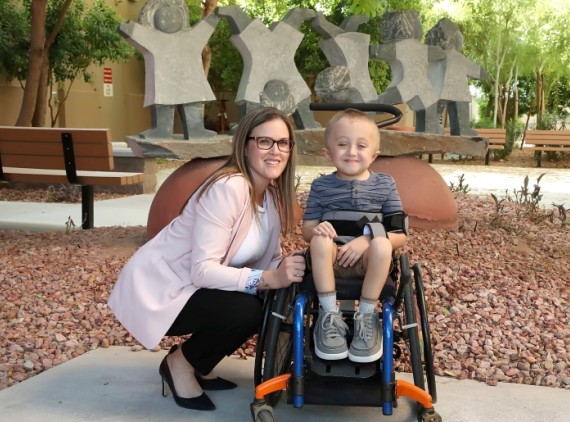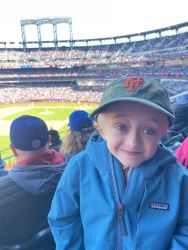
Although his physicians and his parents did not know it at the time, Theo came into the world in 2016 with multiple broken bones. All his mother, Christina, and her husband, Jared, knew was that their fourth child, Theo, was inconsolable, crying all the time no matter what they did to comfort him.
When Theo was four weeks old, Christina heard a loud pop as she was burping him. He let out a cry and his arm went limp. Christina knew something was seriously wrong.
In an Oklahoma emergency department near their home at the time, Theo’s X-ray showed a badly broken arm. Doctors ordered a more extensive series of X-rays that yielded astounding results: 14 broken bones and more skull fractures than the radiologist could count. He was immediately admitted and received genetic testing. Theo’s parents learned that his condition was not a result of an inherited genetic disorder, but a spontaneous one.
Theo’s parents were extremely worried and tried to understand what was happening with their son.
In short order, Theo’s medical team solved the mystery of Theo’s pain and his multiple breaks. Theo was diagnosed with osteogenesis imperfecta (OI), often called brittle bone disease. Children with OI can come from families with no history of the disorder.
“This was the beginning of Theo’s incredible medical journey,” said Christina.
Understanding OI
OI is a genetic condition affecting the gene that forms collagen, the connective tissue found throughout the body, particularly in the bones, ligaments and teeth. Children with OI are born with brittle or fragile bones that bow and break very easily. Theo has Type III OI, the most severe type among children who survive the newborn stage.
Armed with Theo’s diagnosis, his family searched for a specialist to treat him. They found orthopedic surgeon Maegen Wallace, MD, who was leading the OI Clinic at Children’s Nebraska in Omaha. Dr. Wallace is now the Surgical Director of the Metabolic Bone and Osteogenesis Imperfecta Clinic at Phoenix Children's.
“Dr. Wallace was a godsend,” Christina recalled. “She and her team helped us understand Theo’s condition and created his treatment plan, giving us much-needed hope for his future. Families from all over the world were bringing their children to see her in Omaha. We traveled regularly from our home in Oklahoma to keep Theo in her care. When my husband’s job took us to Phoenix, we continued to travel back to Omaha to see Dr. Wallace. We were thrilled beyond belief when she decided to come to Phoenix Children’s to establish an OI program here.”
Dr. Wallace became interested in OI after her medical fellowship training in pediatric orthopedic surgery. “Another surgeon encouraged me to explore this very complex condition, mentoring me as I learned more about managing and treating children with OI,” said Dr. Wallace. “Soon, I discovered that these kids are some of my favorite patients. Their families are truly amazing, and I really enjoy performing the rodding surgery that we use to support OI children’s bones. The surgery makes such a difference for these kids. In our field, it is unusual for an orthopedic surgeon to be involved in a child’s care for a lifetime, but I have come to really cherish these relationships.”
Now at Phoenix Children's OI Clinic, Dr. Wallace has led the creation of the first team of specialists focused on managing the varied and long-term needs of OI patients. The condition ultimately can affect many parts of the body. The team’s goal is to help prevent those issues or to identify them as early as possible when treatment can be most effective. Dr. Wallace’s team includes an endocrinologist and geneticist, as well as experts in pulmonary function, hearing loss, physical therapy, occupational therapy and pain management.
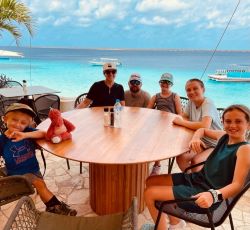
Theo’s journey continues
At the outset of Theo’s journey, his treatment was two-pronged. He was prescribed zoledronic acid, a bisphosphonate that helps strengthen his bones, and when he was just 14 months old, Dr. Wallace’s team performed his first rodding procedure. This surgery involved Dr. Wallace implanting telescopic rods into both femurs (thigh bones) to provide support and help reduce the risk of breaks. This surgery gave Theo the ability to crawl on his hands and knees, as his femurs were previously bowed at almost 90 degrees. In addition, Theo now has rods in both humerus bones in his arms, both tibias, and stabilizing K-wires in his left forearm. He’s also had several rod replacements over the years for a total of 11 surgeries to date. Without these life-changing procedures, Theo would be in a nearly immobile state.
“We generally start with the femurs, because in cases like Theo’s, it’s not a matter of if they break but rather when they break,” explained Dr. Wallace. “We want to place the rods as early as possible to avoid a displaced femur fracture, which is very painful. Doing it in the controlled and safe environment of the operating room allows us to provide the patient with excellent care and good pain management.”
For Theo, pain management is critical. At Phoenix Children’s that can include medication as well as such strategies as meditation, distraction tools and coping mechanisms for both the patient and family.
“Theo lives in pain every day,” Christina said. “The first year was the hardest because it was overwhelming, and there was certainly a grieving period. We had to learn to change his diaper, bathe and burp Theo without causing a break and even more pain. Our family was very guarded when he was younger. Over the years, we have learned to help him participate in life as safely as possible.”
Theo now attends school and plays in a special baseball league, using a plastic bat and “running” the bases with a walker. He participates in wheelchair track and adaptive bowling and loves to swim because the water is his “safe space.” Theo has even been skiing, fitted into a protective shell that sits atop his skis.
“Every family has its own risk tolerance,” explained Dr. Wallace. “Theo and his family are incredibly open to new opportunities and ways to embrace living. That’s why I say that OI patients and their families are amazing.”
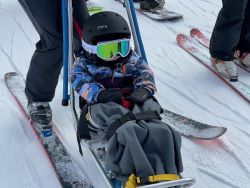
Two key aspects of OI patient care
Dr. Wallace reflected on the two important life lessons she’s learned while working in the OI field.
“First, I’ve learned to listen,” she said. “Listen to each family because they know what their child needs. Listen to the children when they are old enough to communicate because they are very insightful. They know their bodies. They can tell you what’s happening.”
“Second, I’ve learned how important trust is in these relationships,” Dr. Wallace continued. “Families entrust me with their children at very vulnerable and scary times. I assure them that I am with their child every step of the way, even as they go into the operating room. My team knows that they don’t move my patients onto the operating room table, for example, until I’m there. With a family’s trust, a child’s trust, we can make progress together.”
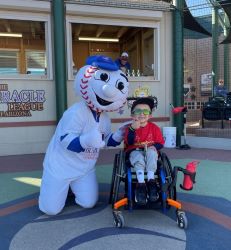
Going forward, Theo and his family will continue to work closely with Dr. Wallace, watching for long-term issues that may affect his lungs, heart or spine. They also plan to support him as he tries to be as active as possible, engaging with friends at school and in the community. His family continues to be fascinated as they watch his journey touch the lives of so many others.
“We know Theo’s going to break,” said Christina. “We also know that he has to live – and he lives his life with tremendous purpose and gratitude.”
At Phoenix Children’s new OI Clinic, patients benefit from leading-edge techniques that can make a positive impact on the lives of children with OI. During our two-day OI Clinic, patients receive testing and benefit from consultations with both the primary clinic team and other Phoenix Children’s specialists. Having the patient’s team of providers and the family all together as part of the consultation is instrumental in developing the appropriate care plan.
For families with children affected by OI who are in need of evaluation or treatment, please contact our OI Clinic today.
To make an appointment, please click here.

